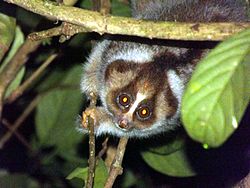Nycticebus kayan is a strepsirrhine primate and a species of slow loris that is native to the northern and central highland region of the island of Borneo. The species was originally thought to be a part of the Bornean slow loris (N. menagensis) population until 2013, when a study of museum specimens and photographs identified distinct facial markings, which helped to differentiate it. It is distinguished by the high contrast of its black and white facial features, as well as the shape and width of the stripes of its facial markings.
The species is named after the Kayan River, which runs through its native habitat. As with other slow lorises, this arboreal and nocturnal species primarily eats insects, tree gum, nectar, and fruit and has a toxic bite, a unique feature among primates. Although not yet evaluated by the International Union for Conservation of Nature (IUCN), it is likely to be listed as "Vulnerable" or placed in a higher-risk category when its conservation status is assessed. It is primarily threatened by habitat loss and the illegal wildlife trade.
